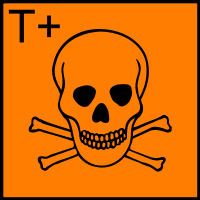|
Storage Condition
|
|
Room Temperature (15-30°C)
|
 Show
data source Show
data source
|
|
|
Storage Warning
|
|
Air Sensitive
|
 Show
data source Show
data source
|
|
|
RTECS
|
|
VY8050000
|
 Show
data source Show
data source
|
|
|
European Hazard Symbols
|
|
Highly toxic (T+)
|
 Show
data source Show
data source
|
 Nature polluting (N) Nature polluting (N)
|
 Show
data source Show
data source
|
 Highly toxic (T+) Highly toxic (T+)
|
 Show
data source Show
data source
|
|
Very dangerous for the environment (N)
|
 Show
data source Show
data source
|
|
|
UN Number
|
|
1687
|
 Show
data source Show
data source
|
|
UN1687
|
 Show
data source Show
data source
|
|
|
MSDS Link
|
|
|
German water hazard class
|
|
2
|
 Show
data source Show
data source
|
|
|
Hazard Class
|
|
6.1
|
 Show
data source Show
data source
|
|
|
Packing Group
|
|
2
|
 Show
data source Show
data source
|
|
II
|
 Show
data source Show
data source
|
|
|
Risk Statements
|
|
28-32-50/53
|
 Show
data source Show
data source
|
|
R:28-32-50/53
|
 Show
data source Show
data source
|
|
R28, R32, R50/53
|
 Show
data source Show
data source
|
|
|
Safety Statements
|
|
28-45-60-61
|
 Show
data source Show
data source
|
|
S:28-45-60-61
|
 Show
data source Show
data source
|
|
S1/2, S28, S45, S60, S61
|
 Show
data source Show
data source
|
|
|
EU Classification
|
|
T2
|
 Show
data source Show
data source
|
|
|
EU Hazard Identification Number
|
|
6.1B
|
 Show
data source Show
data source
|
|
|
Emergency Response Guidebook(ERG) Number
|
|
153
|
 Show
data source Show
data source
|
|
|
TSCA Listed
|
|
是
|
 Show
data source Show
data source
|
|
|
EU Index
|
|
011-004-00-7
|
 Show
data source Show
data source
|
|
|
GHS Pictograms
|

|
 Show
data source Show
data source
|

|
 Show
data source Show
data source
|
|
|
GHS Signal Word
|
|
Danger
|
 Show
data source Show
data source
|
|
|
NFPA704
|
|
|
 Show
data source Show
data source
|
|
|
LD50
|
|
27 mg/kg (oral, rats/mice)
|
 Show
data source Show
data source
|
|
|
GHS Hazard statements
|
|
H300-H400-H410
|
 Show
data source Show
data source
|
|
H300-H410
|
 Show
data source Show
data source
|
|
|
GHS Precautionary statements
|
|
P264-P273-P301 + P310-P501
|
 Show
data source Show
data source
|
|
P273-P264-P301+P310-P321-P405-P501A
|
 Show
data source Show
data source
|
|
|
Personal Protective Equipment
|
|
Eyeshields, Faceshields, full-face particle respirator type N100 (US), Gloves, respirator cartridge type N100 (US), type P1 (EN143) respirator filter, type P3 (EN 143) respirator cartridges
|
 Show
data source Show
data source
|
|
|
RID/ADR
|
|
UN 1687 6.1/PG 2
|
 Show
data source Show
data source
|
|
|
Supplemental Hazard Statements
|
|
Contact with acids liberates very toxic gas.
|
 Show
data source Show
data source
|
|